Rubber putty wedge
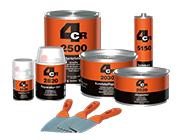
Putty wedge for bodywork
-
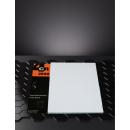 2690.0100Putty mixing board255x215mm x 100 sheets
2690.0100Putty mixing board255x215mm x 100 sheets -
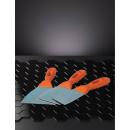 2710.0xxxSteel spatulaSolvent-resistant
2710.0xxxSteel spatulaSolvent-resistant -
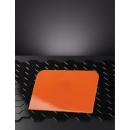 2711.0120Plastic spatula 120mmSolvent-resistant
2711.0120Plastic spatula 120mmSolvent-resistant -
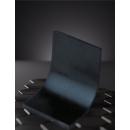 2712.xxxxRubber spatulaSolvent-resistant
2712.xxxxRubber spatulaSolvent-resistant -
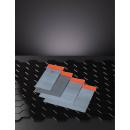 2713.0001Japanese spatula kit5 - 8 - 10 - 12cm
2713.0001Japanese spatula kit5 - 8 - 10 - 12cm
︾
Everything you need to know about Putty wedges for bodywork repairs:
Putty wedges are an essential tool for bodywork professionals when preparing surfaces before painting. It can be used to :
- Smooth and shape the putty: after applying bodywork putty (polyester or Fiberglass polyester), the putty wedge ensures even distribution of the product over the damaged area, whether it's a dent, scratch or crack.
- Control the thickness of the putty: it makes it easier to remove excess putty, ensuring an even thickness that prevents visible defects after painting.
- Optimise sanding: a surface shaped correctly with the shim enables faster, more even sanding, reducing the risk of indentations or excess thickness.
- Use a rigid shim for flat surfaces and a flexible shim for curves or complex contours.
- Use the right abrasive paper for the job (coarse grit for roughing, fine grit for finishing) for optimum results.
- Regularly check the continuity of surfaces under a grazing light to avoid irregularities before painting.
How do I use a putty wedge?
Putty wedges are an essential tool in the bodywork industry for ensuring even application and efficient sanding of polyester putty. Used correctly, it saves time and ensures a perfectly smooth surface before painting.
1. Surface preparation :
Before applying Putty:
- Thoroughly degrease the area to be worked(anti-silicone cleaner)
- Sand the exposed sheet metal (generally from P80 to P120) to ensure good adhesion.
- Remove dust and dry the surface
2. Apply the putty with a putty wedge:
- Take the putty mixed with the Hardener
- Place the material on the Putty wedge
- Spread the product firmly over the damaged area, pressing evenly
- Work in criss-cross strokes to follow the shape of the bodywork
- Remove excess Putty to limit the amount of sanding required.
A rigid shim is recommended for flat surfaces, while a flexible shim is better suited to curves and curved areas.
3. Shaping and sanding :
Once the Putty has cured:
- Use the shim with P80-P120 coarse abrasive paper to roughen the surface.
- Check the surface regularly under a grazing light.
- Then change to an intermediate grit to refine
- Finish with a fine grit to prepare the surface for the application of the Primer filler.
A few impact spanners for a professional result:
- Always keep the block flat to avoid hollows
- Work in long, even strokes rather than small ones
- Alternate sanding directions to even out the surface
- Check evenness by hand: a perfectly smooth surface should be imperceptible to the touch
Using a putty wedge correctly will ensure precise bodywork, reduce sanding time and ensure a perfect finish before painting.
Why use a putty wedge?
Putty wedges are an essential tool for any bodywork professional wanting to achieve perfectly smooth surfaces ready for painting. It has a number of technical advantages:
1. Precise smoothing of putty :
After applying polyester putty, the Putty wedge helps to shape the material and spread it evenly. This reduces excess and ensures a flat surface or one that follows the curves of the bodywork perfectly.
2. Checking thickness :
A properly used Putty wedge ensures an even thickness, avoiding areas that are too thin or too thick, which could create visible defects after painting.
3. Optimising sanding :
By working the material as soon as it is applied with the spacer, sanding becomes faster and more efficient, limiting the risk of hollows or dents and making it easier to finish the Primer.
4. Adaptability to body shapes:
The shims are available in a rigid version for flat surfaces and a flexible version for curved surfaces, making it possible to work on all areas of the vehicle, even complex curves.
5. Time-saving and professional quality:
Correct use of the Putty wedge reduces the number of sanding passes, cuts down on putty wastage and produces a uniform result, guaranteeing a clean, durable finish after paintwork.
When should a bodybuilder's putty wedge be used?
The putty wedge is a practical accessory that can be used in a variety of bodywork repair situations, in particular to ensure an optimum finish before painting.
1. Repairing dents and scratches:
When the sheet metal is deformed or has deep scratches:
- Polyester Putty is applied to fill dents and imperfections
- The Putty wedge is used to shape the product, even out the thickness and create a flat surface or one adapted to the curves of the vehicle.
2. Preparation before sanding :
Before applying primer or paint:
- The shim ensures an even surface, limiting sanding time
- It allows irregularities to be detected and corrected
3. Working on flat or curved surfaces :
- Flat surfaces: use a rigid shim for precise, uniform smoothing
- Curved and contoured surfaces: use a flexible shim to follow the contours without digging into the material.
4. Optimising time and quality:
Using the Putty wedge in these situations allows you to:
- Reduce the number of sanding passes
- Reduce Putty waste
- Guarantee professional Preparation for a perfect Paint finish
Putty wedges are used whenever putty needs to be applied and shaped, whether for light repairs or more complex bodywork, to ensure precision, consistency and professional quality.
What's the difference between a rubber putty wedge and a steel spatula?
The rubber putty wedge and the steel spatula are two complementary tools used in different contexts during bodywork. The rubber putty wedge is designed for working on curved or contoured surfaces. Its flexibility allows it to adapt perfectly to the shape of the vehicle and spread the Putty evenly without digging into the contours. It is ideal for final smoothing and for preparing surfaces before sanding, ensuring an even thickness on difficult curves.
The steel spatula, on the other hand, is rigid and is mainly used for applying and shaping putty on flat or slightly curved surfaces. It allows you to apply the material quickly, fill in dents and scratches, and precisely control the thickness of the putty as soon as it is applied. Its rigidity makes it quicker to work on large flat surfaces, but it is less suited to complex contours because it can dig into the putty on curves.
To sum up, the main difference lies in flexibility and use: the rubber putty wedge is flexible and suited to curves for precise smoothing, while the steel spatula is rigid and ideal for applying and shaping putty on flat or slightly curved surfaces. For professional work, the two tools are often used in tandem, the spatula to apply the putty and the putty wedge to smooth it and prepare the surface for sanding.
How much do putty wedges cost?
The cost of a putty wedge depends on a number of factors: materials (rubber, plastic, steel), dimensions, flexibility, resistance to solvents, packaging (individually or in batches), brand, etc.
Generally speaking, a medium-sized flexible rubber shim will cost between €2 and €5 inc VAT for a professional-quality product. For a smaller or simple flexible shim, the price can drop to around €1 or €2.
What influences the price?
There are a number of things that can influence the price of putty wedges:
> Material: flexible rubber generally costs more than simple Plastic, but less than treated or stainless steel. Resistance to solvents, the presence of a special coating, etc. all add to the cost.
> Size and shape: a wide (or very long) shim or one with a shape adapted to complex curves will be more expensive than a small standard shim.
> Flexibility: for rounded surfaces, very flexible shims are slightly more expensive.
> Packaging: buying individual shims is more expensive per piece, but unit prices are lower in batches or packs.
> Brand/professional quality: recognised brands, with meticulous finishes or guaranteed durability, can cost 30-50% more than "entry-level" shims.
What are putty's applications?
Bodywork putty is an essential product in car repairs for finishing work, preparing surfaces before painting and ensuring a professional finish. It has a wide range of applications, mainly for repairing, protecting and finishing vehicles.
Putty is primarily used to fill dents, scratches, cracks or impacts on metal, plastic or composite surfaces. After straightening the sheet metal or sanding the damaged area, Putty fills in the irregularities and creates a flat, even surface, essential for an optimum paint finish.
It is also used to correct imperfections on the curves or complex contours of vehicles. In this case, the choice of putty (standard, Fiberglass, polyester or special Plastic) depends on the nature of the substrate and the depth of the repair.
In addition to cosmetic repairs, putty plays a role in preparing surfaces for priming and painting. It makes sanding easier and creates a perfectly smooth finish, reducing the risk of visible defects such as indentations, dents or sanding marks.
Putty can also be used for light structural repairs, for example to reinforce certain areas of bodywork or fragile plastic parts, while remaining compatible with paint and anti-corrosion treatments.
Bodywork putty is used to fill, smooth and correct all imperfections on a vehicle, whether on sheet metal, plastics or composite surfaces, guaranteeing a professional job and an impeccable paint finish.
In conclusion, the Putty wedge is the ideal tool for all bodywork professionals who want to easily carry out high-precision repairs on all types of subtrate, whether car or motorbike. Thanks to its resilient design and high-quality materials, it is perfectly resistant to intensive use, solvents and temperature variations when the Putty dries. Available in a range of sizes and colours, it can be adapted to suit every need, guaranteeing optimum durability.
Distributed in France and Europe by Carross, the Putty wedge meets the needs of professional bodybuilders looking for a precise, hard-wearing and easy-to-use tool. Whether you're working with a paint spray gun or preparing a surface for finishing, this accessory is a must-have in the workshop.
You can buy your Putty wedges online with complete confidence: benefit from secure payment, fast delivery and a selection based on the latest innovations in the sector. Professional putty wedges are the ideal choice for even application, more efficient sanding and high-quality results that last.
Don't hesitate to contact our customer service team, available every day from Monday to Friday, for any information about our Putty wedges.